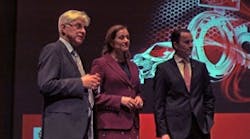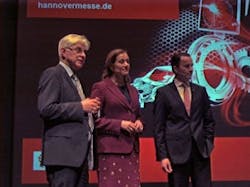Only movies offer coming attractions, not industrial trade shows, right? Wrong.
Undoubtedly the world's largest and most comprehensive manufacturing exhibition, Hannover Messe's organizers presented a preview of its upcoming 2014 edition on Feb. 11 at the Radialsystem V hall in Berlin, Germany.
The fair will be held April 7-11 in its more than two dozen huge exhibition spaces in Hannover. However, the preview helped attendees to get an early look at some of the event's major innovations and exhibitors. All were focused on its primary "Integrated Industry — Next Steps" theme and the specific steps needed to bring the Smart Factory concept to life using the integrated tools of Industry 4.0, or a fourth industrial revolution driven by Internet-connected devices. To help boost its Integrated Industry strategy, Hannover Messe has enlisted the Netherlands as its 2014 partner country.
Prof. Dr.-ing. Detlef Zuehlke, scientific director for Innovative Factory Systems (IFS) at the German Research Center for Artificial Intelligence, Dutch ambassador Monique T.G. van Daalan, and Deutsche Messe board member Dr. Jochen Koeckler answer questions after their presentations during the Hannover Messe Preview in Berlin, Germany.
Putting the upcoming fair in a global context, Deutsche Messe board member Dr. Jochen Koeckler reported that wages are increasing in China, energy costs are decreasing in the U.S., and added Europe's economic recovery will be led by a predicted 3% production increase in 2014, which will be fueled by investments in municipal infrastructures, manufacturing and machines. As a result, Koeckler projected that Hannover Messe is expected to top its 2012 results of 4,872 exhibitors from 69 nations.
"When people ask me to describe Hannover Messe in a nutshell, I say it's all about competitiveness," said Koeckler. "It's about people coming together to exchange ideas that will produce efficiencies, generate investments, and make them more competitive. These days, it's no longer about big companies eating small companies; it's about fast ones eating slow ones. However, to stay competitive, manufacturers need flexible, intelligent factories of the future in which machines, plant and products can talk to each other. This interaction will relieve skilled workers of physical labor, and enable them to focus on better controlling and optimizing production processes. Many technologies for achieving this have been developing in recent years, and the next steps are integrating them into industrial production to form a harmonized and fully networked whole. This is Hannover Messe's precise focus, and the upcoming fair will present the steps industry must take to move from its smart-factory vision to a real-life, integrated, Industry 4.0 factory."
More specific steps for achieving the fair's Integrated Industry concept were presented by Prof. Dr.-ing. Detlef Zuehlke, scientific director for Innovative Factory Systems (IFS) at the German Research Center for Artificial Intelligence, which has been developing its Smart Factory KL program since 2005. "Just as we have smart phones with data available anywhere and anytime, and we're moving toward smart homes and smart cars, we're also going to need smart factories," said Zuehlke. "They'll be more flexible and agile to handle more varied products, and have shortened production steps, such as quicker set up and retooling times and modular components that are easy to plug and play. Some jobs are coming home and being reshored, but these efforts will only succeed with automation to make them competitive. However, we don't want empty factories either; we want smart factories that will create new and enriching jobs for everyone. Smart machines are going to need smart operators, smart product designers and smart managers."
Zuehlke explained these Smart Factories will be constructed from a variety of building blocks, starting with cyber physical system (CPSs) and smart production line components, which will be linked via OPC-UA and other networking protocols to enterprising resource planning (ERP) systems. "Usually, field devices deliver signals to controllers and fieldbus systems, but now field devices with their own Internet protocol (IP) addresses will just network via web servers, which are already less costly and can be combined like Lego blocks to form larger systems. Until now, control architectures have been very hierarchical, and data had to thorough a pyramid of field, control and enterprise levels, each with their own programs. However, in a smart, CPS-based network, this old hierarchy goes away, and all participating elements can talk to each other as needed. Also, this CPS world will make operators with tablet PCs smarter as well because they'll have better access to more values, improved location awareness, and the ability to make better decisions."
Besides presenting full-scale models of how Smart Factories will operate, Hannover Messe's exhibitors will show many Industry 4.0 tools they can use to make their applications and facilities smarter. For example, Zuehlke added that one Smart Factory demonstration will consist of a five-module production line for assembling business card boxes with secure RFID tags. The integrated line consists of a quality assurance section by Lapp Kabel, laser engraving section by Phoenix Contact, and three assembly sections by Harting and Bosch Rexroth. Each section will have smart machine components to coordinate tasks with the others, network via TCP/IP, WiFi and RJ45 protocols, and follow Han-modular standards for plug-and-play connectors.
Other exhibitors providing early glimpses of Industry 4.0 solutions and their exhibits at the Hannover Messe Preview included:
• Ziehl-Abegg demonstrated its new Owlet bionic fan blades, which are designed using nature's principles, made from lighter, castor oil-based plastic, and have saw tooth-edged blades to greatly reduce air turbulence and noise.
• First-time exhibitor ZF Friedrichshafen AG, which builds automotive drive lines and has 19 manufacturing facilities in the U.S, alone, plans to show its new Ecomix II mixer transmission, but it's also going to highlight its migration into renewable energy by exhibiting its new Atlas I wind-power gearbox with one planetary stage and two helical stages for high-torque applications.
• ifm electronic GmbH debuted the latest generation of its PN pressure sensors, which have been its best sellers for 20 years, and are now updated with high-overload protection, IP67 ratings, laser labeling, increased display size, two switching-status LEDs, and simpler, one-tooling installation.
• Weidmuller exhibited its u-remote I/O system with modular design, single-row connection strip with status LEDs and high-density cabling. It provides remote I/O connections to machines via Profibus, Profinet, DeviceNet and EtherNet/IP, or via a web browser, and comes with a QR code for immediate access to its instruction manual.
• Festo previewed its SupraMotion low-power, super-conductivity research projects, which typically require 80 watts to cool and 12 watts to maintain operations. Though no specific products have been developed yet, SupraMotion is likely to have many practical applications in material handling and transportation in the future.
• Beckhoff Automation reported that its PC-based control solutions, including TwinCAT 3 automation software and EtherCAT networking aided by the OPC-UA communication specification can aid Smart Factory and Industry 4.0 efforts. Together, they can enable consistent communication from the sensor to the cloud; machine to machine (M2M) and Internet of Things (IoT) communications; new diagnostic and interface concepts using web browsers and Google Glass interfaces; integration of drives and robotics; reduced commissioning with real-time simulations; and integrated safety and security functions.
• Bosch Rexroth explained that its Open Core Engineering (OCE) software and Open Core Interface (OCI) can help machine builders use smart devices for commissioning, diagnosis and operations. It added that users can program apps for these functions, and OCI will ensure the machine's control understands and carries out orders from these apps. OCI automatically makes several programming languages available to controllers, and so machine builders can create higher-level programs without writing any PLC code, and reduce programming efforts by up to 50%.
• Harting KGaA added it will demonstrate its joint FlexiMon — Flexible Assembly Concept, which uses autonomous manufacturing components. This program is one of 46 projects by 174 cluster partners in the Intelligent Technical Systems OstWestfalenLippe (IT'S OWL) program to develop Industry 4.0 technologies. Harting will exhibit the interplay and simplified configurability of several production islands, including processes for screwing, stamping and inspecting.
Jim Montague is the executive editor for Control, Control Design and Industrial Networking. Email him at [email protected] or check out his Google+ profile.

Leaders relevant to this article:




